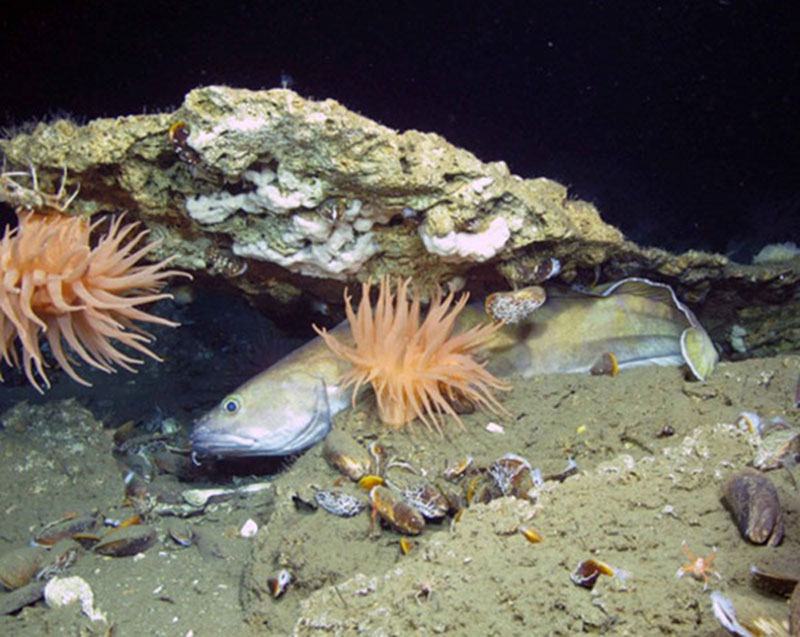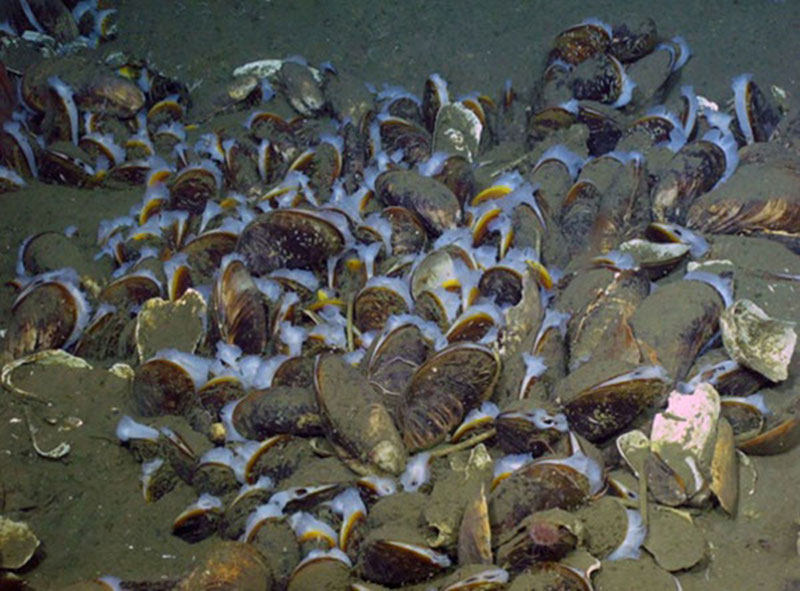
By
Sandra Brooke - Marine Conservation Institute/OIMB
Steve W. Ross - UNC-W, Center for Marine Science
August 26, 2012

Figure 1: A large fish called a Cusk sheltering under a rocky ledge, surrounded by live seep mussels. Image courtesy of Deepwater Canyons 2012 Expedition, NOAA-OER/BOEM. Download image (jpg, 118 KB).
In the early 1980’s Dr. Barbara Hecker was lead scientist on an exploration cruise in Baltimore Canyon, using a towed camera to survey the seafloor. When she processed the film (real film, not digital files!) she saw several frames with images of mussel beds. She deduced that these mussels were indicative of a methane cold seep, something that was unknown for the US Atlantic coast at the time. It was quite a discovery, but the cruise was past and she did not have an opportunity to return. Fast-forward over three decades and the seeps became a target of interest for our Atlantic Deepwater Canyons project.
Navigation technology has changed a lot in 30 years; Dr. Hecker’s locations were logged using Loran C which cannot be accurately translated into the GPS coordinates we use today. Her camera system did not have real-time data transfer to the ship, so it’s actual location on the seafloor could only be estimated. They did however have a depth sensor on the camera sled. Using estimates of location, and the depth range over which Dr. Hecker recorded mussel images, we began searching for the seeps. We are using the ROV Kraken II (U. Connecticut), which has sophisticated navigation technology to tell us exactly where we are during the dive, a high definition video camera and the ability to make collections.

Figure 2: White bacterial mats indicate seep activity. Image courtesy of Deepwater Canyons 2012 Expedition, NOAA-OER/BOEM. Download image (jpg, 123 KB).

Figure 3: A red crab trying to crack open a seep mussel, while someone else awaits the outcome with interest! Image courtesy of Deepwater Canyons 2012 Expedition, NOAA-OER/BOEM. Download image (jpg, 160 KB).
Our first dive began on the south side of a large knoll on the western flank of the canyon. We followed the 420 m depth contour around the knoll and after about an hour started seeing scattered dead mussel shells. As we proceeded these shells became more abundant and live mussels began to appear - so we knew we were getting close! As we moved further north, we came across large rocky slabs that were covered in live mussels as well as anemones, sponges, hydroids and all the usual animals we had been seeing in the non-seep areas. We also saw large fish called Cusk (Brosme brosme) sheltering under these ledges, so obviously the methane seeping out of the seafloor did not seem to bother the other fauna. A variety of other fishes were also common, such as goosefish, rattails and a type of flatfish called tonguefish. By the end of the first dive, we knew we had found seep activity, but Dr. Hecker’s images clearly showed a flat swath of dense mussel beds so we weren’t quite there yet…...
The next day we dropped down close to the end of the first dive and before long we saw the tell-tale mussel shells and patches of white bacteria that indicate seep activity. In several places around the seep area we also observed methane bubbles venting through the sediment. As we moved along the shells became more abundant and we were suddenly in the thick of a dense patch of live mussels, with their bright white siphons glowing in the camera lights. Tiny spider crabs, shrimp, brittlestars and other small creatures were nestled down amongst the shells, while larger animals such as eels and red crabs wandered over the surface of the bed. A red crab was seen wrestling with a large mussel, obviously intent on dinner.

Figure 4: A patch of live mussels, their bright white siphons clearly visible against their dark shells. Image courtesy of Deepwater Canyons 2012 Expedition, NOAA-OER/BOEM. Download image (jpg, 122 KB).
Although we have not mapped it out entirely yet, this seep site seems to cover a considerable area, and at 400-430 m it is also very shallow compared to the Blake Ridge (2000-3000 m depth), which is the only other known seep area off the US east coast. Unlike other methane seeps the Baltimore seep seems to have only mussels; we have seen no indications of other seep-specific animals such as clams and tubeworms. We know from other studies that these types of mussels can use both chemosynthesis (bacteria in the tissues use methane to produce organic material) and can filter feed like normal mussels. It may be that these seeps produce enough methane to support the mussels, but not enough for those animals that reply on only chemosynthesis. We have taken samples of live mussels to determine which species they are and various aspects of their biology, and will continue to dive on this site to learn more about the extent of the seep area and the animal communities that live there. There is always more work to do, but for now we are excited to have re-discovered this unusual ecosystem that was last seen over 30 years ago.